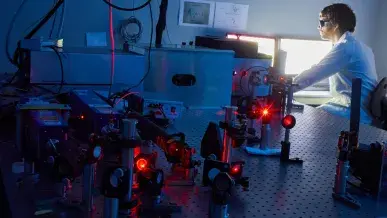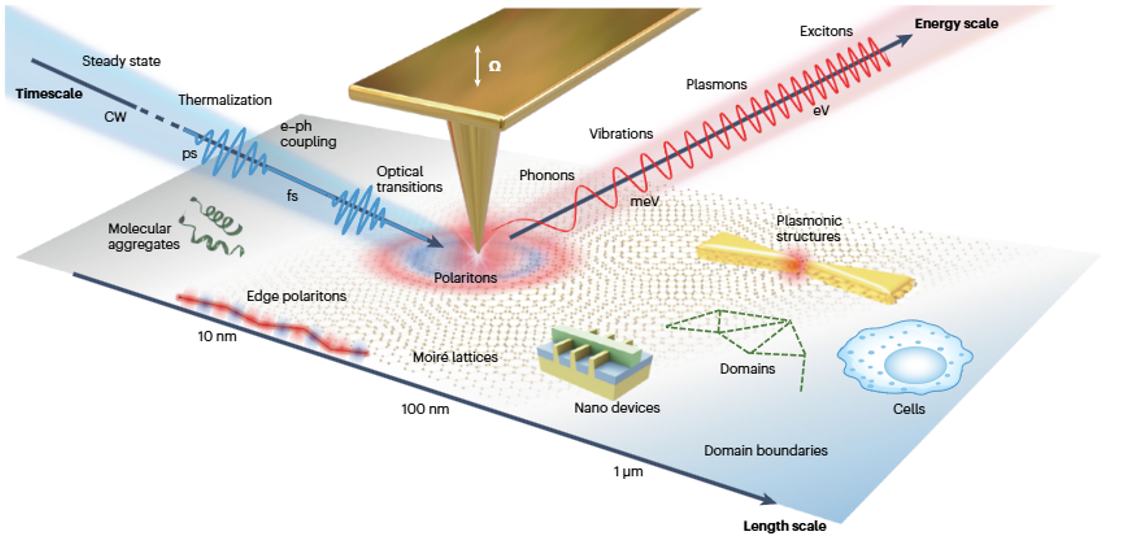Review Article Highlights 25 Years of Modern Near-field Optical Nanoimaging
A newly published review article in Nature Reviews Materials highlights the groundbreaking impact of scattering-type scanning near-field optical microscopy (s-SNOM), a technique that surpasses the diffraction limit to achieve nanoscale optical imaging across a broad spectral range. Authored by leading experts in the field, the review traces the evolution of s-SNOM and its expanding applications in nanophotonics, materials science, and quantum research.

Conventional optical microscopy is constrained by the diffraction limit, preventing the visualization of features smaller than half the illumination wavelength. s-SNOM overcomes this barrier by utilizing an atomic force microscope (AFM) tip illuminated with light from the visible to the terahertz range. By capturing elastically scattered light from the tip while scanning a sample, s-SNOM achieves an extraordinary resolution of 10 nanometers—independent of the illumination wavelength.
 The foundation of SNOM based on light scattering at AFM tips was laid in the 1990s, but early implementations suffered from strong background signals, limiting the reliability of the images. In 2000, Rainer Hillenbrand, first author of the review article, together with Fritz Keilmann, introduced modern s-SNOM instrumentation utilizing interferometric detection and higher harmonic signal demodulation. These advancements eliminated background signals, making s-SNOM a reliable and widely adopted technique. Hillenbrand, since 2008 an Ikerbasque Research Professor and Nanooptics group leader at CIC nanoGUNE, also played a key role in the commercialization of s-SNOM as a co-founder of the company Neaspec (now part of Attocube Systems), enabling its widespread adoption in academia and industry. Today, s-SNOM is an essential tool for exploring challenges in nanotechnology, quantum materials, and biological systems.
The foundation of SNOM based on light scattering at AFM tips was laid in the 1990s, but early implementations suffered from strong background signals, limiting the reliability of the images. In 2000, Rainer Hillenbrand, first author of the review article, together with Fritz Keilmann, introduced modern s-SNOM instrumentation utilizing interferometric detection and higher harmonic signal demodulation. These advancements eliminated background signals, making s-SNOM a reliable and widely adopted technique. Hillenbrand, since 2008 an Ikerbasque Research Professor and Nanooptics group leader at CIC nanoGUNE, also played a key role in the commercialization of s-SNOM as a co-founder of the company Neaspec (now part of Attocube Systems), enabling its widespread adoption in academia and industry. Today, s-SNOM is an essential tool for exploring challenges in nanotechnology, quantum materials, and biological systems.
The review provides an in-depth discussion of the principles underlying s-SNOM and its unique capabilities in label-free imaging of diverse materials. It explores the technique’s sensitivity to plasmons, phonons, and excitons, allowing for precise characterization of electronic, chemical, and structural properties at the nanoscale. Additionally, the article highlights recent advancements that extend s-SNOM’s applicability under extreme conditions, such as cryogenic temperatures, external fields, and liquid environments, further broadening its relevance for fundamental and applied research.
This comprehensive review underscores how s-SNOM continues to push the boundaries of optical nanoimaging, offering unparalleled insights into the nanoscopic world. As the field advances, the technique is expected to play a crucial role in next-generation scientific and technological breakthroughs.
R. Hillenbrand, Y. Abate, M. Liu, X. Chen, and D. N. Basov
Nature Review Materials (2025)
